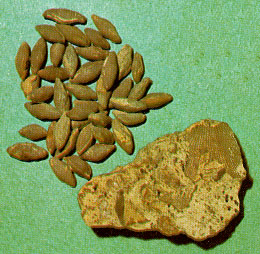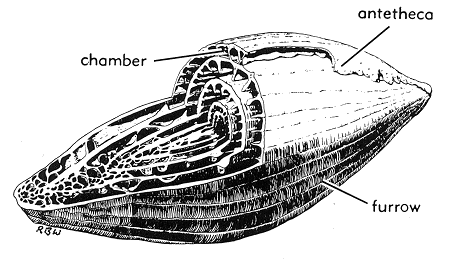
Ancient Life in Kansas Rocks, part 6 of 27
Appearing commonly in the rocks of eastern Kansas are small wheat-grain-like fossils called foraminifers. These amoeba-like animals secrete a hard skeleton and grow to amazing size for one-celled organisms. The foraminifers in the upper left are termed fusulinids, derived from the Latin word for spindle (photo slightly enlarged). They were exclusively marine, living in clear offshore water. The particular fusulinids in the photograph are Triticites, named from the Latin word for wheat. (Beil Limestone, Upper Pennsylvanian)

Along the side of the specimens may be seen a prominent line called an antetheca (see drawing below). This was the growing surface, and as the animal grew, adding chambers along the the long axis, the antetheca extended forward. Starting as a small spherical shell, the animal added material, elongating the shell, and developing longer and longer chambers, one at a time. As each chamber was added, a groove called a furrow was left on the outside leaving a trace of the previous antetheca. Many fusulinids resemble each other externally, and in order to properly identify them they must be cut and studied internally.

A piece of limestone at the lower right of the photograph contains both a fusulinid and a fragment of the lacy type of bryozoans termed fenestellids.
Kansas Geological Survey
Placed online Feb. 1997
URL = "http://www.kgs.ku.edu/Publications/ancient/f06_fusulin.html"
Send comments and/or suggestions to webadmin@kgs.ku.edu